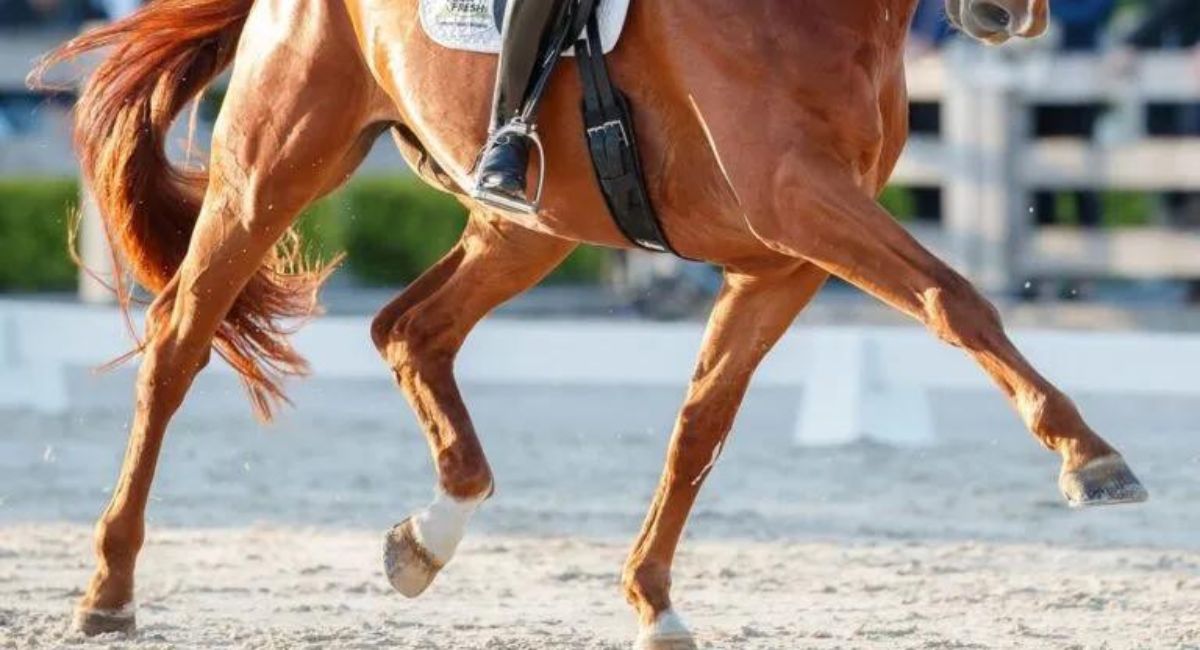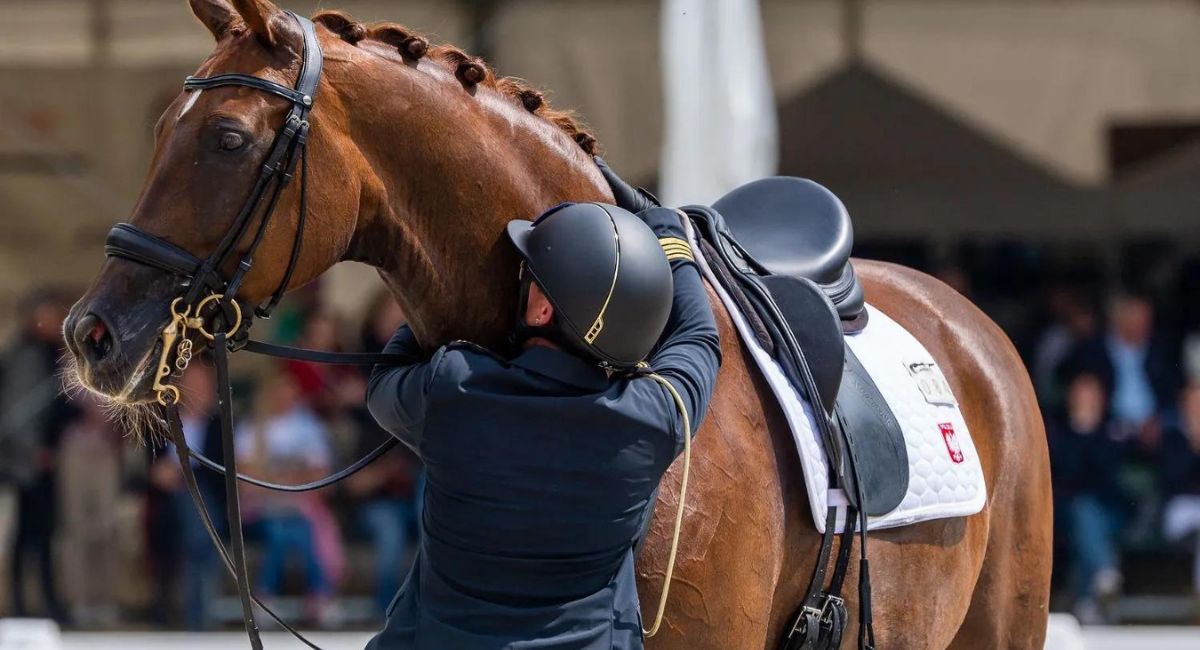Menu

How is horse welfare actually faring in Denmark? We have asked the Danish Equestrian Federation about it, as well as what the association is doing to optimize horse welfare.
Most of us have probably seen the two most recent Operation X programs on TV 2. Here, the public gets an insight into the renowned dressage stable, Helgstrand Dressage, and the training methods used there. Methods, which are contrary to the ethical guidelines of the Danish Equestrian Federation for how we can ride our horses in an ethical and proper way. The programs have undoubtedly initiated a necessary and important debate, not just within the horse world.
The question is whether equestrian sports need a service check and a cultural change, where horse welfare is prioritized over the rider's ambitions. But what is good horse welfare actually today?
Read also: Beet fibers for horses – What are they, and what are their benefits?
"For me, good horse welfare is when there is a balance between the rider's ambitions and the horse's abilities. When a rider is able to read and understand the horse's signals. Also, one should be able to understand its behavior and conflict markers and have respect for its nature," explains Morten Schram Rodtwitt, director of the Danish Equestrian Federation (DRF).
Source: Landbrugsinfo, Guide: Law on Keeping Horses, where you can also read the full guide and accompanying comments.
You can read the rest here on the DRF's website.
The above is based on horse welfare during riding as well as in general handling. In recent years, the general conditions for horse welfare have been adjusted. The conditions, for example, concern the size of the horse's box, its social needs, and nutritional needs.
Read also: Warmblood horses have 4.6 times higher risk of back problems
If you see something that contradicts the above, you can either contact the police or Hestens Værn (The Horse's Shelter). Call 114 (Or your local authorities number) and ask for the animal welfare unit.
Here you can read more about Hestens Værn (The Horse's Shelter) and their work.
The DRF's ethical guidelines are there to ensure a basic level of horse welfare. Although we might wish that the ethical guidelines from the DRF as well as the rules in the horse welfare law were enforced and complied with in all Danish stables, we must unfortunately realize that this is not always the case – neither at the hobby level nor at the top level.
"We can establish rules and frameworks, but we cannot go around to all stables and enforce them. We all have a responsibility to speak up when we see improper riding. Our guidelines are ones that all riders can lean on, whether they compete or not, but there is a high degree of self-regulation. We can keep an eye on competitions, but we cannot oversee what happens during training at home," explains Morten.
DID YOU KNOW ... In Denmark, there are at least 100,000 active riders, of which about 56,168 are members of the DRF.
Source: Den Store Danske and DRF
The director of the Danish Equestrian Federation points out that there is also a responsibility on everyone involved with horses. From leisure riders to top riders.
"We cannot and should not generalize all riders, but there are areas where we can do better. There needs to be a moral compass for how we have horses."
This requires us to stand together across the entire horse world. The Forum for Horse Welfare, or Hestevelfærdsforum, is a platform for a range of organizations concerning horses in Denmark, including the Danish Equestrian Federation, Danish Galop, Danish Trotting Sports Central Association, Danish Icelandic Horse Association, Hestens Værn, relevant departments of SEGES, and the Danish Veterinary Association. The purpose of the association is to increase welfare for horses by, among other things, preparing joint responses to relevant legislative proposals. Furthermore, the DRF has set up a working group that is specifically looking at promoting horse welfare in Denmark.
The Council Recommends that the Equestrian Industry Makes a Further Effort to Clarify What Is and Is Not Acceptable, to Spread Awareness of the Riding Federation's Rules, to Exercise a Higher Degree of Control with Compliance Both in and Out of Competition, and Finally, to Introduce (Further) Sanctions if the Rules are Not Followed.
The Ethical Council for Animals
There is no doubt that our view of horse welfare is constantly changing. However, in many ways, we probably need to separate horse welfare in the stable and horse welfare during riding.
Even though horses can stand in large boxes with shiny coats, there is no guarantee that it is a horse in good condition. If we as riders, for example, do not listen to the horse's stress signals and conflict markers, it does not create a well-being in the horse.
Read also: Balance, strength, and flexibility. Should your horse do pilates?
"We need to look at the culture where the goal is to train a horse as quickly as possible. When we train our horses, it must be done in a good and responsible manner with respect for the horse, and we must take the necessary time for training," explains Morten.
The Ethical Council for Animals does not find it problematic in itself that horses are used for purposes such as sport, but the Council notes that the use for sporting purposes involves a risk that horses are pressed and limited in ways that can compromise their welfare. The Council believes that there is a need to focus more on how horses can be used in sport while their welfare is more highly prioritized and catered to. Therefore, the Council assesses that practices and traditions around horse sports should be evaluated in the light of the knowledge that exists about horse behavior and welfare today, as well as contemporary norms for keeping and using animals.
Following this, the Council recommends ensuring that the education of persons responsible for keeping horses, training, teaching, and holding competitions, sufficiently covers horse behavior, including conflict behavior, and is up-to-date in terms of training methods and norms for horse welfare. The Council further recommends that rules be set for the education of those responsible for a professional horsekeeping, as per the possibility in § 22 of the animal welfare law to set such requirements.
According to Morten, in Denmark, we have the right frameworks and rules to a large extent, which can ensure horse welfare. But this requires that they are adhered to.
"I think we have done a lot in recent years. Ten years ago, our focus was more on rider safety, but today we are trying to focus greatly on the welfare and safety of the horse, for example, by educating horse people, so the consideration of the horse weighs heaviest. Then our ambitions must come in second place."
A change in horse welfare and culture requires that we start in the riding schools around Denmark.
"The riding schools are where many riders get their basic understanding of horses and riding. Therefore, it is extremely important that one already gets a basic understanding of the horse and its behavior there."
"We, as a riding federation, must educate young riders to put horse welfare highest. Here, I think we are really well on our way in our riding schools and through our teaching concepts. We are looking, among other things, at e-courses focusing on horse welfare, for example, school horses, which should give a basic understanding of good horse welfare."

At the top of the sport, changes must also occur if we are to ensure horse welfare during riding. The horse should not just be an athlete who must fulfill the riders' ambitions at the expense of its well-being and welfare.
"We also need to continually adapt and adjust, especially how we judge – particularly in dressage. There should be more inspections and better control from our judges and officials, who should be sharp on what good horse welfare is. We need to be clearer in our rules, and then we need to enforce them better."
Horse welfare has been a topic, especially recently, that has occupied both horse people and non-horse people. Most recently, the Ethical Council for Animals came with a statement on the use of horses for sport.
"I believe and hope that there are most riders who have horses in a respectful and proper manner and train with a great understanding of the horse. But therefore, I still believe we need to have this debate now. It's a big cultural change, where there will undoubtedly be bumps in the road, but it's extremely important that we take up this fight now," explains Morten and continues:
"Now we all stop and look at how and where we need to improve, so we don't find ourselves in a similar situation in five or ten years. No one wants to experience that again."
Read also: Muscles tell the tale: Is your horse using its body correctly in training?